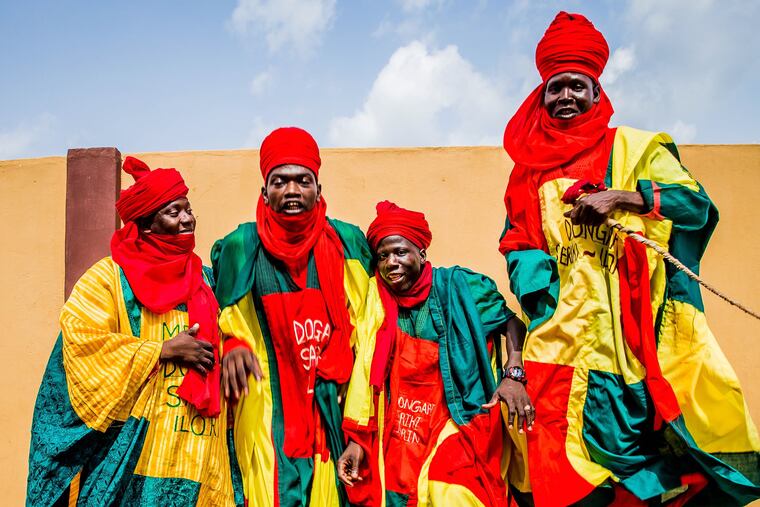‘In Conversation’ at the African American Museum wants you to rethink black masculinity
"In Conversation: Visual Meditations on Black Masculinity" is a photography exhibit with work by more than 50 women and gender non-conforming photographers. It challenges preconceived notions about blackness and asks viewers to reconsider how masculinity (and gender) is defined.

On a whim, Kirwyn Sutherland of Germantown visited the African American Museum in Philadelphia. He had an idea of what the current exhibit would entail: photographs of black men. But he didn’t expect to feel so “seen.”
In Conversation: Visual Meditations on Black Masculinity (running through March 1) is a photography exhibit with work by more than 50 female and gender-nonconforming photographers that challenges preconceived notions and compels viewers to reconsider how masculinity (and gender) is defined.
For Sutherland, the variety of the images — from men wearing muscle shirts and Timberland boots to others in top hats and creased slacks — made him both appreciative and overwhelmed, “in a good way.”
The exhibit is loosely organized into three sections: documentary photography, visual art, and gender-nonconforming photography. Subjects range from business owners and poets to such public figures as Barack Obama, James Baldwin, Teddy Pendergrass, and Bob Marley, among others.
Men of different ages are featured to illustrate the “cycling of life," said Dejay Duckett, director of curatorial services at the museum. Joy, brotherhood, and fatherhood are some recurring themes. We see men embracing, men in uniforms, and men at leisure. There’s also a section that focuses on gender and the male anatomy.
“There were quite a few images that showed bigger bodies alongside everyone else,” Sutherland said, which resonated with him. "Being a bigger, heavyset person, you don’t really feel seen in photography.”
» READ MORE: Larger men get honest about finding clothes in a slim-fit world
Several of the pieces in the exhibition are an homage to people in the photographer’s family. For instance, when Brooklyn photographer Danielle Noel gave birth, her child’s father took a prominent role in caring for their infant. The show includes a tender black-and-white photograph of him, shirtless and feeding their daughter.
A series of eight photographs by Baltimore photographer Phylicia Ghee show her grandfather, who has been a painter for most of his life but is now losing his eyesight. She has become his caretaker, and there’s an intimate portrait of the photographer in her grandfather’s arms.
Brooklyn-based curators Laylah Amatullah Barrayn and Adama Delphine Fawundu said they were inspired to create the exhibit last year after visiting the Underground Museum in Los Angeles and seeing a 1972 issue of Ebony Magazine that highlighted the aesthetics of black men.
“It was interesting that the issue wasn’t only about black men in America,” Barrayn said. “It looked at men across the diaspora and what it meant to be a black man in the ’70s." The duo followed this model with one major difference: Their exhibit would be exclusively from the viewpoint of women and nonbinary photographers.
“If you’re interested in the liberation of black people — socially, politically, and culturally — black masculinity has to be on the table,” said Alex Jones, a Los Angeles-based expert in African American art history, unaffiliated with the AAMP exhibit. “Black women and nonbinary people, in particular, have looked at masculinity and gender in more radical ways because it’s always been a facet of their lives, whether they identify with it or not."
Jones believes that traditional notions of black masculinity have perpetuated negative stereotypes associated with aggression and dominance. One of the ways of redefining masculinity is to take a wider view.
» READ MORE: Meet the Philly photographer who’s questioning masculinity
To accomplish this, Fawundu said the duo reached out to dozens of photographers from around the world — including Ethiopia, Brazil, and Haiti — and “we got such an array of beautiful images and different ideas of what black masculinity meant.”
Vibrant crimson, yellow, and turquoise garments compete only with the smiles of Nigeran men in a photograph shot by Tolani Alli. In a portrait shot by Melissa Alexander, Atlanta rapper Ziggy2Playa stands with his hands clutched at his waist and his head slightly turned, displaying a pink flower poised at his right ear.
Having a variety of viewpoints is the key to the exhibit’s emotional draw, said Fawundu, who’s worked with Barrayn since 2002.
Both curators said they’d like viewers to feel empowered after seeing the exhibit. As photographer Toni Black writes in one exhibit label: “The journey to being a (care) free black man is easier for some than others. But either way, the destination is beautiful.”